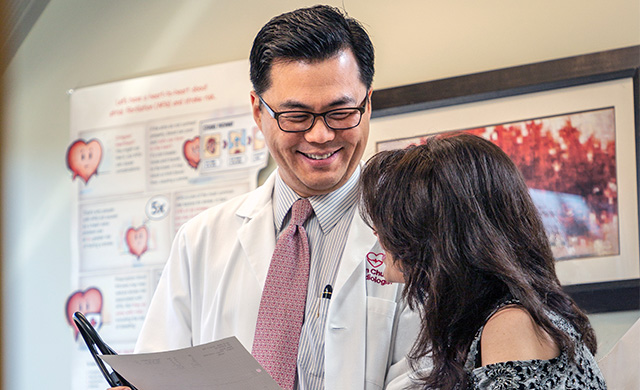Cardiac Computed Tomography (CT)
We use x-ray equipment to produce pictures of your coronary arteries to see if they are blocked or narrowed by plaque. The test result is known as your cardiac calcium score.
Cardiac Magnetic Resonance Imaging (MRI)
We use radio waves, magnets, and a computer to create detailed pictures of your heart, These images help us to diagnose heart problems such as coronary artery disease, heart valve problems or damage from a heart attack.
Echocardiogram
Also called an “echo,” this test is done to check how the valves and chambers of your heart are working. The test can also reveal the size of the heart and the thickness and movement of the heart wall.
During an echocardiogram, a health care provider — typically a radiographer or sonographer — uses ultrasound to create a moving picture of your heart. Echocardiograms are painless and noninvasive.
Electrocardiogram (EKG)
Often called an “EKG” or “ECG” for short, an electrocardiogram measures your heart’s electrical activity, including your heart’s rate and rhythm. The test can detect ischemia (lack of oxygen to the heart), heart attack, and a variety of other conditions.
During an EKG, a health care technician places sensors on your chest, arms, and legs. The sensors are connected to an electrocardiogram machine, which creates a three-dimensional map of your heart’s electrical rhythm. You simply lie still while the map is made. EKGs are painless and noninvasive.
Exercise Stress Test
During this test sensors are placed on your chest to record your heart as you exercise on a treadmill or stationary bike. We monitor and record your heart rate and electrical activity, breathing, and blood pressure. We also note any symptoms you may experience to look for indications of coronary artery disease and angina (that chest pain caused by a shortage of oxygen reaching the heart muscle).
Nuclear Stress Test (Pharmacological Nuclear Stress Test)
In order to give us a better view of your cardiovascular system, a provider will deliver a small amount of radioactive dye into a vein for this test. Then a special camera detects the radiation and produces computer images of your heart that show blood flow.
Like an exercise stress test, this is a diagnostic tool that helps our physicians spot signs of heart conditions such as coronary artery disease (CAD).
Transesophageal Echocardiogram (TEE)
By passing a very small tube through your esophagus, we are able to see your heart’s activity through an ultrasound. This way, we can obtain very clear images of your heart to help diagnose certain disorders.
